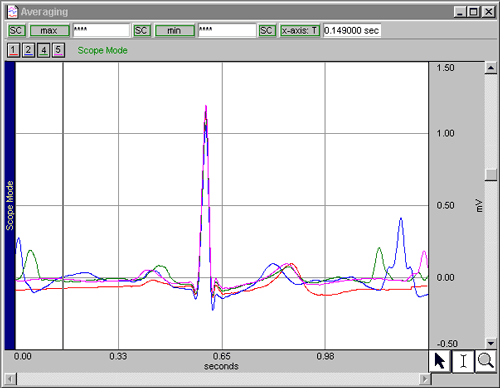H23 Signal Averaging ECG

The Biopac Student Lab system can be used to amplify and enhance the ECG signal using a clinical diagnosis tool referred to as the Signal Averaged ECG. The technique allows identification of small electrical currents, called ventricular (ven-TRIK’u-ler) late potentials. This test is used to help identify people at risk of a dangerous rhythm in the heart’s lower (pumping) chambers. This is called ventricular arrhythmia (ah-RITH’me-ah) and it can lead to sudden cardiac death.
For years, cardiologists examined paper charts of ECG signals to create an averaged ECG complex. They took each individual cardiac cycle, measured each part of the complex with a ruler, wrote down each value, and calculated the means to derive an averaged ECG complex. This task took a great deal of time and patience. When the need arose to analyze two or more different scenarios (e.g., baselineresponse), the task had to be performed even more carefully for accurate comparison of the ECGs.
The BSL PRO software has a powerful averaging feature that automatically derives an averaged signal from a specific number of cycles (averaging is found in the Find Peak dialogue). It also can easily compare two, three, or more averaged ECG signals.
Experimental Objectives
-
Optional: Record multiple segments of ECG data under different conditions.
-
Provide a Signal Averaged ECG for each of the recording segments.
-
Compare the Signal Averaged ECG data for different conditions.
Tasks Performed by the Student
Subject will:
- lie down,
- sit up quickly,
- breathe deeply, and then
- exercise (such as sit-ups, jumping jacks, etc).
Videos
Biopac Student Lab Student Download
Student Prep & Distance Learning
Click the link(s) below for sample data and/or lesson procedure video(s), BSL PRO Lesson procedures (PDF) for human lessons*, and graph template files (*.gtl) for BSL PRO Lessons. If more than one .gtl is available, download the .gtl with the _suffix to match BSL version and hardware.
Lesson Hardware
This lesson requires a Biopac Student Lab (BSL) System and the following hardware. If your BSL System does not include all hardware items, expand your system by selecting required items below. For more details, review the Lesson: L# BSL Lessons - see the Lab Manual or launch BSL; A# and H# BSL PRO Lessons, click the PDF link above to review full setup, recording, and analysis procedures.
| Item | Name | Cart |
|---|---|---|
| ELPAD | Abrasive Pads 10/pk | Add to Cart |
| GEL1 | Electrode gel 50 g | Add to Cart |
| SS2LB | Lead set, shielded, BSL | Add to Cart |
| EL503 | Disp. Gen-purp electrode 100/pk | Add to Cart |
Stay Connected